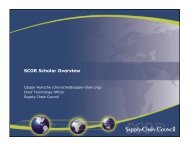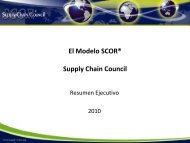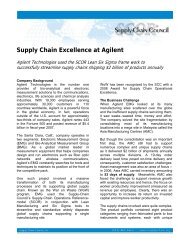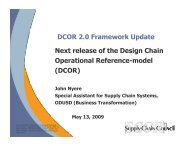PLCOR Project Discussion.pdf - Supply Chain Council
PLCOR Project Discussion.pdf - Supply Chain Council
PLCOR Project Discussion.pdf - Supply Chain Council
- No tags were found...
You also want an ePaper? Increase the reach of your titles
YUMPU automatically turns print PDFs into web optimized ePapers that Google loves.
Reference Model for Marketing &Innovation ManagementAlbrecht Ricken – SAP AGRoss Young – Intel CorporationDan Swartwood – Satellite Logistics Group© 2012 <strong>Supply</strong> <strong>Chain</strong> <strong>Council</strong>. ALL RIGHTS RESERVED. | 2012SCWNA – Marketing & Innovation Management model - Ricken, Young, Swartwood | Slide 1 | 1 April 2012
Today’s SpeakersDr. Albrecht Ricken, Sr. Director, Global Business Incubator, SAP AG› 18 years in supply chain consulting, as of 2002 with a focus on SCOR› SAP practice lead supply chain for Latin America (1998 – 2002)› Program coordinator for market introduction of non-incremental innovations at SAP (since 2008)› Creator of the xPLOR modelRoss Young, Operations Program Manager & <strong>Supply</strong> <strong>Chain</strong> Integrator, Intel Corporation› 24 years of experience in the Semiconductor industry.› Currently working within Intel’s <strong>Supply</strong> <strong>Chain</strong> Management organization focused on enabling new capabilities.› APICS Certified <strong>Supply</strong> <strong>Chain</strong> Professional (CSCP)› Lean Manufacturing Methodology experience & Six Sigma Executive Leadership Training & Green Belt Certification› PMI Industry Certification (PMP)Dan Swartwood, Vice President of Process & Technology, Satellite Logistics Group› 25 years manufacturing management experience with 3M Company and Imation Enterprises› 10 years management consulting experience in Aerospace, Pharmaceutical, Industrial, Chemical, and Paperindustries focusing on <strong>Supply</strong> <strong>Chain</strong> Analysis, Lean, and Six Sigma› Chairman <strong>Supply</strong>-<strong>Chain</strong> <strong>Council</strong> Technical Development Steering Committee (2005-2007)› SCC Board of Directors (2005-2007)› Author of “Fix Your <strong>Supply</strong> <strong>Chain</strong>” (May 2009)› Speaker on <strong>Supply</strong> <strong>Chain</strong>, Transformation, Continuous Improvement› Certified APICS, SCOR Master Instructor, Lean and Six Sigma© 2012 <strong>Supply</strong> <strong>Chain</strong> <strong>Council</strong>. ALL RIGHTS RESERVED. | 2012SCWNA – Marketing & Innovation Management model - Ricken, Young, Swartwood | Slide 2 | 1 April 2012
Attendee Takeaways• Definition of Innovation & Product Management• Product Lifecycle Operations Reference (<strong>PLCOR</strong>) modelknowledge› Introduction of current Level 1 & 2› Highlight of integration points between <strong>PLCOR</strong> and <strong>Supply</strong> <strong>Chain</strong> Management as well as DCOR› Illustration of the integrations with a fictional example• Importance, Application and Value Add Opportunities for your<strong>Supply</strong> <strong>Chain</strong> by applying <strong>PLCOR</strong>• Next steps to continue to learn and apply <strong>PLCOR</strong> to yourbusiness through our Special Interest Group’s meetings & workproduct© 2012 <strong>Supply</strong> <strong>Chain</strong> <strong>Council</strong>. ALL RIGHTS RESERVED. | 2012SCWNA – Marketing & Innovation Management model - Ricken, Young, Swartwood | Slide 3 | 1 April 2012
What it is?Why would you care?PRODUCT MANAGEMENT ANDINNOVATION© 2012 <strong>Supply</strong> <strong>Chain</strong> <strong>Council</strong>. ALL RIGHTS RESERVED. | 2012SCWNA – Marketing & Innovation Management model - Ricken, Young, Swartwood | Slide 4 | 1 April 2012
Marketing and Innovation• “At the heart of a greatbrand is a great product” 1› Successful new productsand services continue tobe one of the mostimportant factors forrevenue growth• Most companies today are“Marketing” driven› “Marketing orientationevolved from earlierorientations, namely, theproduction orientation, theproduct orientation and theselling orientation”Orientation Profit driverProductionProductSellingMarketingProductionmethodsQuality of theproductSellingmethodsNeeds andwants ofcustomersWesterntimeframeuntil the1950suntil the1960s1950s and1960s1970 topresent day1Philip Kotler: A Framework for Marketing Management© 2012 <strong>Supply</strong> <strong>Chain</strong> <strong>Council</strong>. ALL RIGHTS RESERVED. | 2012SCWNA – Marketing & Innovation Management model - Ricken, Young, Swartwood | Slide 5 | 1 April 2012
Key Terms In A FlashMarketingactivitiesInnovationNot justAdvertisingNot justsomething newThe 4 Ps:Product, Pricing, Placement, PromotionSomething new, which a buyer usesProductManagementNot justpromoting aproductThe 3 Cs:1. Create: Define something of value tobuyers2. Communicate: Make sure that the buyerunderstands the value3. Consume: Make sure that the buyerreceives his valueProductLifecycleManagementNot justa curve froma textbookVary tactics to match the maturity of aproduct in the market© 2012 <strong>Supply</strong> <strong>Chain</strong> <strong>Council</strong>. ALL RIGHTS RESERVED. | 2012SCWNA – Marketing & Innovation Management model - Ricken, Young, Swartwood | Slide 6 | 1 April 2012
Customer Expectations Evolve along The Lifecycle(Product Requirements, <strong>Supply</strong> <strong>Chain</strong> Requirements change, too)Product LifecycleThechasmIntroduction Growth Mass AdoptionCustomers■ Focused on the latest technology■ Willing to work hard to make anew technology workProduct■ Innovative solution■ “Custom development” as anoption<strong>Supply</strong> <strong>Chain</strong> Implication■ Early, young market■ Product success highly uncertain■ Focus on flexibilityCustomers■ Wants to get excited by the cool,new product■ Less technologically sophisticatedProduct■ Stable and scalable solution<strong>Supply</strong> <strong>Chain</strong> Implication■ Demand patterns emerge■ Focus on speed andresponsivenessCustomers■ Product must be mainstream■ Less sophisticated userProduct■ Complete and standardizedsolution■ Commodity stage<strong>Supply</strong> <strong>Chain</strong> Implication■ Predictable demand patterns■ Focus on reliability, efficiency, andquality© 2012 <strong>Supply</strong> <strong>Chain</strong> <strong>Council</strong>. ALL RIGHTS RESERVED. | 2012SCWNA – Marketing & Innovation Management model - Ricken, Young, Swartwood | Slide 7 | 1 April 2012
Why would we care aboutProduct Lifecycle Management?© 2012 <strong>Supply</strong> <strong>Chain</strong> <strong>Council</strong>. ALL RIGHTS RESERVED. | 2012SCWNA – Marketing & Innovation Management model - Ricken, Young, Swartwood | Slide 8 | 1 April 2012
Identify Competitive RequirementsPerformanceAttribute orCategoryEarlyAdopterCompetitive RequirementsInnovatorMature• “Basis of competition” isselected in marketing.• “Competitive requirements”is an outcome of productpositioning• Not a SCOR but a <strong>PLCOR</strong>activityReliability S A SResponsivenessFlexibilityA P ACost P S PAssetManagement P P P• Procedure› Prioritize supply chainperformance requirements foreach relevant customer/marketchannel- Within a channel, you get1 superior (S), 1 advantage (A),and 2 parity (P)› Each unique combination ofratings defines Your <strong>Supply</strong> <strong>Chain</strong>Strategy for the channel› Think of the rating as a desiredstate, NOT where you want toimprove the most© 2012 <strong>Supply</strong> <strong>Chain</strong> <strong>Council</strong>. ALL RIGHTS RESERVED. | 2012SCWNA – Marketing & Innovation Management model - Ricken, Young, Swartwood | Slide 9 | 1 April 2012
Group <strong>Discussion</strong>• How would you describe the link between yourmarketing/sales group and supply chain groups(operations)?LOW 1 2 3 4 5 HIGH• If your rating was low(1-3), what issues existbecause of this?© 2012 <strong>Supply</strong> <strong>Chain</strong> <strong>Council</strong>. ALL RIGHTS RESERVED. | 2012SCWNA – Marketing & Innovation Management model - Ricken, Young, Swartwood | Slide 10 | 1 April 20121
How do I apply this to existing models?What are the opportunities for higher value add in the SC?<strong>PLCOR</strong>APPLICATION AND VALUE ADD© 2012 <strong>Supply</strong> <strong>Chain</strong> <strong>Council</strong>. ALL RIGHTS RESERVED. | 2012SCWNA – Marketing & Innovation Management model - Ricken, Young, Swartwood | Slide 11 | 1 April 20121
Opportunity and Value Proposition• Current Situation› The <strong>Supply</strong> <strong>Chain</strong> <strong>Council</strong> has developed multiple referencemodels that are complimentary to the SCOR model. The latest isspecific to Product Lifecycle Management across the supply chain.• Opportunity for Intel› Help mold this new industry reference model for optimumapplication within our Industry by providing feedback on content,application and key metrics• Potential Value Proposition› Opportunity to decrease our Innovation Cycle Time. Enables amore proactive discovery process for new product driven SCcapabilities.› Opportunity to improved alignment with our S&M/Div partnersand supply chain segments.© 2012 <strong>Supply</strong> <strong>Chain</strong> <strong>Council</strong>. ALL RIGHTS RESERVED. | 2012SCWNA – Marketing & Innovation Management model - Ricken, Young, Swartwood | Slide 12 | 1 April 2012
Each supply chain segment needs to clearly understandthe unique product and/or customer driven requirementsExamples:1. Responsive <strong>Supply</strong> <strong>Chain</strong> has evolved from specific historical product/customersegment requirements.2. Efficient <strong>Supply</strong> <strong>Chain</strong> has historically drafted off of a responsive supply chain.Continuous Improvement Process focused to drive cost/efficient improvementsby removing on-value add activities. Note: This is ever evolving …..3. Agile <strong>Supply</strong> <strong>Chain</strong> utilizes the front end of the traditional responsive supplychain, but has custom products (dedicated SKU/customer), services (licensing& fusing) and/or unique inventory strategies.1. What are our key business metrics?2. What is the level of innovation/risk?3. How does this impact the supply chain?4. How do we “optimize” performance?© 2012 <strong>Supply</strong> <strong>Chain</strong> <strong>Council</strong>. ALL RIGHTS RESERVED. | 2012SCWNA – Marketing & Innovation Management model - Ricken, Young, Swartwood | Slide 13 | 1 April 201213
Where does the <strong>Supply</strong> <strong>Chain</strong> play acrossthe Product Life Cycle?Product LifecycleNewTechnologypushed to SCBest time to alignand influenceReactive and nonoptimizedsolutionsThechasmFill the factoryOptimize capacityMissedopportunitiesUnnecessary RiskBegin to deprioritize1-10yrproduct lifecycle?Introduction Growth Mass AdoptionAnswer: It depends……..1. What group you are part of: Research, Development, Manufacturing, Planning, Logistics, others2. What role you play: Tactical, strategic, process-focused, metric-focused, customer-focused, supply chainfocusedOpportunity to help standardize and drive proactive engagement and alignmentacross the multiple <strong>Supply</strong> <strong>Chain</strong> Segments© 2012 <strong>Supply</strong> <strong>Chain</strong> <strong>Council</strong>. ALL RIGHTS RESERVED. | 2012SCWNA – Marketing & Innovation Management model - Ricken, Young, Swartwood | Slide 14 | 1 April 20121
Scope of Product Lifecycle OperationsPlan Portfolio of future and existing productsCreate Offering: From idea to product release• Specify and define the 4 Ps• Product development and pricing• Definition of positioning: How to explain the product value• Definition of placement: Channels, eco-system, definitionof supply chainGo-to-Market: From product release to sales success• Execute Go-to-Market activities• Communicate the value of the innovation such that userssubscribeDeploy: From sales success to customer value• Physically deliver the product or give access, consume• Meet customer expectations, make users successfulRevise: Receive and channel market feedback• Feedback from analysts, press, customers, research• Positive and negative, unsolicited ideasEnable: Management processesTiming ImpactBest opportunity to intercept newproduct requirementsNote: Balance between innovation/risk levels andstrategic priorities will be critical. Businessstrategy is key to determining timing.Reactive to new product requirementsHistorically missed opportunities to optimize earlyin the product life cycle or supply chain segmentdevelopmentMissed opportunities can addUnnecessary SC Risk• Missed New and Emerging Market SCrequirements• SC Metric Performance• Customer Satisfaction Scores• $Push “Value” Up Stream in The Product Life Cycle!© 2012 <strong>Supply</strong> <strong>Chain</strong> <strong>Council</strong>. ALL RIGHTS RESERVED. | 2012SCWNA – Marketing & Innovation Management model - Ricken, Young, Swartwood | Slide 15 | 1 April 20121
What are the business objectives behindInnovation & Product Lifecycle Management?Performance AttributeLevel-1 Metric (entire Product Lifecycle)MarketReliability(think of user value)Responsiveness(think of adoption speed)AgilityCustomer SatisfactionPerfect Product LaunchProduct (or Brand) LoyaltyTime to Tipping PointTime-to-VolumeTime-to-marketProduct Portfolio Value at riskInnovation CTis part of havingVelocityengrained intoour <strong>Supply</strong> <strong>Chain</strong>DNAInternalCostAssetsProduct Management CostProduct ROIDifferentiate between pure SPEED (how fast)vs.controlled Velocity (purposeful acceleration)© 2012 <strong>Supply</strong> <strong>Chain</strong> <strong>Council</strong>. ALL RIGHTS RESERVED. | 2012SCWNA – Marketing & Innovation Management model - Ricken, Young, Swartwood | Slide 16 | 1 April 2012
How could Innovation & Product Lifecycle Managementconcepts add value in your company?GROUP DISCUSSION© 2012 <strong>Supply</strong> <strong>Chain</strong> <strong>Council</strong>. ALL RIGHTS RESERVED. | 2012SCWNA – Marketing & Innovation Management model - Ricken, Young, Swartwood | Slide 17 | 1 April 2012
High Level Model for multiple SCSegments and Design for SCNeed higher levels of collaboration,connectivity and communicationacross all supply chain segments ifoptimization is to be realized.SC #xSegSC #1SegSC #2Seg1. Maximize value and minimize rework.Drive this through existing workinggroups.2. Keep up with changing environmentaland business/customer requirements.SC #5SegDesignfor SCSC #4SegSC #3Seg© 2012 <strong>Supply</strong> <strong>Chain</strong> <strong>Council</strong>. ALL RIGHTS RESERVED. | 2012SCWNA – Marketing & Innovation Management model - Ricken, Young, Swartwood | Slide 18 | 1 April 2012
Product Lifecycle Operations Reference Model<strong>PLCOR</strong> OVERVIEW© 2012 <strong>Supply</strong> <strong>Chain</strong> <strong>Council</strong>. ALL RIGHTS RESERVED. | 2012SCWNA – Marketing & Innovation Management model - Ricken, Young, Swartwood | Slide 19 | 1 April 2012
What is the Scope of Product Lifecycle Operations?Plan Portfolio of future and existing productsCreate Offering: From idea to product release› Specify and define the 4 Ps- Product development and pricing- Definition of positioning: How to explain the product value- Definition of placement: Channels, eco-system, definition of supply chainGo-to-Market: From product release to sales success› Execute Go-to-Market activities› Communicate the value of the innovation such that users subscribeDeploy: From sales success to customer value› Physically deliver the product or give access, consume› Meet customer expectations, make users successfulRevise: Receive and channel market feedback› Feedback from analysts, press, customers, research› Positive and negative, unsolicited ideasEnable: Management processes© 2012 <strong>Supply</strong> <strong>Chain</strong> <strong>Council</strong>. ALL RIGHTS RESERVED. | 2012SCWNA – Marketing & Innovation Management model - Ricken, Young, Swartwood | Slide 20 | 1 April 2012
Why does it end with Deploy? (rather than “Launch”)• Consumption, deployment are key activities inproduct lifecycle management.› A criteria for success is that the product is actually usedrather than ending on the shelf› Consumption is the process of actually generatingcustomer value• Creating customer value is key to product success› If a product fails to satisfy customers it will never leavethe stage of market entry› Failure of more mature products typically yields rapiddecline in the market© 2012 <strong>Supply</strong> <strong>Chain</strong> <strong>Council</strong>. ALL RIGHTS RESERVED. | 2012SCWNA – Marketing & Innovation Management model - Ricken, Young, Swartwood | Slide 21 | 1 April 2012
Top-Level KPIsBusiness Objectives behind Innovation & Product ManagementPerformanceAttributeReliabilityResponsivenessLevel-1 Metric (entireProduct Lifecycle)Perfect ProductLaunchCustomer SatisfactionAchievement*Product (or Brand)LoyaltyTime to Tipping PointTime-to-VolumeTime-to-marketExplanationProduct released to market on time and committedsales executed in first year and target customersatisfaction reachedCustomer perception of product value or usefulness.Often measured through customer interviews.% of re-purchases: customers who make a secondpurchase after their firstTime from the start of product creation to the momentwhen the market moves from “push” to “pull”Time from start of product creation to 16% of the targetmarket (Innovators = 2.5% + Early adopters = 13.5%)Time from start of product creation to first 50 customersusing the productNotes:• 50 customers is an arbitrary number• Metric applies to all stages in the lifecycle*see notes section© 2012 <strong>Supply</strong> <strong>Chain</strong> <strong>Council</strong>. ALL RIGHTS RESERVED. | 2012SCWNA – Marketing & Innovation Management model - Ricken, Young, Swartwood | Slide 22 | 1 April 2012
Top-Level KPIsBusiness Objectives behind Innovation & Product ManagementPerformanceAttributeAgilityCostAssetsLevel-1 Metric (entireProduct Lifecycle)Product Portfolio Value atRiskUpside Product LaunchFlexibilityUpside Product LaunchAdaptabilityProduct Management CostProduct ROIExplanationThe sum of the probability of risk events times themonetary impact of the events for all the productlaunch functions (e.g. Plan, Create, Go-to-Market,Deploy, Revise)The number of months required to achieve anunplanned sustainable 20% increase in newproducts launched.The maximum sustainable percentage increase inproducts launched that can be achieved in 1 yearThe cost of operating the product managementprocesses. This includes laborcosts, costs for promotion, costs for sales incentivesand product support costs.© 2012 <strong>Supply</strong> <strong>Chain</strong> <strong>Council</strong>. ALL RIGHTS RESERVED. | 2012SCWNA – Marketing & Innovation Management model - Ricken, Young, Swartwood | Slide 23 | 1 April 2012
High-Level Relation between SCOR and <strong>PLCOR</strong>• Marketing typically drives <strong>Supply</strong> <strong>Chain</strong> Management• <strong>Supply</strong> <strong>Chain</strong> Requirements on Level 1 typically are aresult of Product Positioning› “Basis of competition” is selected in strategic marketing.› These definitions are a result of <strong>PLCOR</strong> activities.© 2012 <strong>Supply</strong> <strong>Chain</strong> <strong>Council</strong>. ALL RIGHTS RESERVED. | 2012SCWNA – Marketing & Innovation Management model - Ricken, Young, Swartwood | Slide 24 | 1 April 2012
High Level Integration with other Reference Models<strong>PLCOR</strong>Create Go-to-Market DeployDCORRequirementsDesignResearch Design IntegrateAmendSalesPipelineContractsReviseCCORRelate Sell ContractMarketing PlanSCORSource Make DeliverAssistDeliveriesReturnFinal interface modeling is planned to be in line with xCOR standards© 2012 <strong>Supply</strong> <strong>Chain</strong> <strong>Council</strong>. ALL RIGHTS RESERVED. | 2012SCWNA – Marketing & Innovation Management model - Ricken, Young, Swartwood | Slide 25 | 1 April 20122
Process CategoriesMacro ProcessesProcess Elements<strong>PLCOR</strong> – LEVEL 2 AND 3© 2012 <strong>Supply</strong> <strong>Chain</strong> <strong>Council</strong>. ALL RIGHTS RESERVED. | 2012SCWNA – Marketing & Innovation Management model - Ricken, Young, Swartwood | Slide 26 | 1 April 2012
Strategic View: Innovation Types Reflect The RiskInnovation Matrix with Incremental, Semi-Radical,and Radical Innovation along the dimensionsTechnology and Business Model (Tony Davila)• Innovation types reflect therisk from the investment› Technology: Is thisinnovation feasible?› Business Model: Will themarkets accept it?• Risks tend to be highest inthe early stages of aproduct life cycle› Generally the riskdecreases with maturityalong the life cycle© 2012 <strong>Supply</strong> <strong>Chain</strong> <strong>Council</strong>. ALL RIGHTS RESERVED. | 2012SCWNA – Marketing & Innovation Management model - Ricken, Young, Swartwood | Slide 27 | 1 April 2012
Operational View: 4 Dimensions of RiskDimensions of risk or:Why the innovation may fail:› We cannot explain the Value Novelty› We do not know how to build it Technology› We need to orchestrate too many players orsystems Complexity› We can’t make it on time PaceNTCP model with added numeric levels, adaptedfrom Shenhar, Aaron J.; Dvir, DovDegree of risk in every dimension reflectsthe gap between the innovator’s capabilitiesand the required capabilities› Distance from the current core© 2012 <strong>Supply</strong> <strong>Chain</strong> <strong>Council</strong>. ALL RIGHTS RESERVED. | 2012SCWNA – Marketing & Innovation Management model - Ricken, Young, Swartwood | Slide 28 | 1 April 2012
The more radical the innovation,the less you can predict operations<strong>PLCOR</strong> Established Adjacent DisruptiveCreate C1 C2 C3Go-to-Market G1 G2 G3Deploy D1 D2 D3• Translate innovation risk into process categories› Established operations apply: Low in any of the 4 dimensions› Adjacency: Knowledge mostly exists, but operations need to be reconfigured oradjusted. Medium or low in any dimension› Disruption to the current core: We need to figure out how to operate the innovationprocess; established operations of little use. High in at least one dimension• Matches SCOR Logic (MTS, MTO, ETO)› Eases model integration© 2012 <strong>Supply</strong> <strong>Chain</strong> <strong>Council</strong>. ALL RIGHTS RESERVED. | 2012SCWNA – Marketing & Innovation Management model - Ricken, Young, Swartwood | Slide 29 | 1 April 20122
Create Go-to-Market DeployC1 Established C2 Adjacent C3 Disruptive G1 Established G2 Adjacent G3 Disruptive D1 Established D2 Adjacent D3 DisruptiveQualify Ideas Qualify Ideas Qualify Ideas Setup GO-TO-MARKET process &organizationSetup DEPLOYprocess &organizationSetup CREATEprocess &organizationSchedule GO-TO-MARKET activitiesSchedule GO-TO-MARKET activitiesSchedule GO-TO-MARKET activitiesSchedule DEPLOYactivitiesSchedule DEPLOYactivitiesSchedule DEPLOYactivitiesSchedule CREATEactivitiesSchedule CREATEactivitiesSchedule CREATEactivitiesPublish Pricelist Publish Pricelist Publish Pricelist Establish customersupport modelEstablish customersupport modelAcquire detailedMarket KnowledgeAcquire detailedMarket KnowledgeTransfer MarketknowledgeTransfer MarketknowledgeTransfer MarketknowledgeTransfer MarketknowledgeSpecify Productfeatures andfunctions andvalidate feasibilityand complianceSpecify Productfeatures andfunctions andvalidate feasibilityand complianceSpecify Productfeatures andfunctions andvalidate feasibilityand complianceRollout saleschannels & otherplacement structuresRollout saleschannels & otherplacement structuresTransfer ProductKnowledgeTransfer ProductKnowledgeTransfer ProductKnowledgeSpecify pricing andvalidate profitabilityagainst assumptionsSpecify pricing andvalidate profitabilityagainst assumptionsSpecify pricing andvalidate profitabilityagainst assumptionsCommunicate ValuePropositionCommunicate ValuePropositionCommunicate ValuePropositionMake productavailable to usersMake productavailable to usersMake productavailable to usersSpecify positioningand validatemessagingSpecify positioningand validatemessagingSpecify positioningand validatemessagingGenerate & MatureLeadsGenerate & MatureLeadsGenerate & MatureLeadsCustomize androllout ProductCustomize androllout ProductCustomize androllout ProductSpecify placementand validatecustomerengagement modelSpecify placementand validatecustomerengagement modelSpecify placementand validatecustomerengagement modelContract users Contract users Contract users Win user references Win user references Win user referencesDevelop and testproductDevelop and testproductDevelop and testproductDevelop Pricing Develop Pricing Develop PricingDevelop and ensurequality of positioningconceptDevelop and ensurequality of placementconceptRelease product tomarketDevelop and ensurequality of positioningconceptDevelop and ensurequality of placementconceptRelease product tomarketDevelop and ensurequality of positioningconceptDevelop and ensurequality of placementconceptRelease product tomarket© 2012 <strong>Supply</strong> <strong>Chain</strong> <strong>Council</strong>. ALL RIGHTS RESERVED. | 2012SCWNA – Marketing & Innovation Management model - Ricken, Young, Swartwood | Slide 30 | 1 April 2012
Plan (Portfolio) Enable ReviseP1 PlanInnovationP2 PlanCreateP3 PlanGTMP4 PlanDeployEP EnablePlanEC EnableCreateEG EnableGTMED EnableDeployR1 GatherFeedbackon VisionR2 GatherFeedbackonExecutionR3 GatherUnsolicitedIdeasIdentify andaggregatemarketopportunities ofexisting andfuture offeringsIdentify andaggregateCREATErequirementsIdentify andaggregate Goto-MarketrequirementsIdentify andaggregateDeployrequirementsEstablish andmanagebusiness rulesfor PLANEstablish andmanagebusiness rulesfor CREATEEstablish andmanagebusiness rulesfor GO-TO-MARKETEstablish andmanagebusiness rulesfor DEPLOYStimulatefeedback onvisionStimulatefeedback onexecutionIdentify andaggregateresources tocapture marketopportunitiesIdentify andaggregateCREATEresourcesIdentify andaggregate Goto-MarketresourcesIdentify andaggregateDeployresourcesManage PLANPerformanceManageCREATEPerformanceManage GO-TO-MARKETPerformanceManageDEPLOYPerformanceCreate feedback Create feedback Generate ideasBalance marketopportunitiesagainst resourceconstraintsBalanceCREATErequirementsvs. resourcesBalance Go-to-Marketrequirementsvs. resourcesBalance Deployrequirementsvs. resourcesManage PLANDataManageCREATE DataManage GO-TO-MARKETDataManageDEPLOY DataReceivefeedbackReceivefeedbackReceive ideasEstablish &communicatePortfolio PlanEstablish &communicateCREATEPortfolioEstablish &communicateGo-to-MarketPortfolioEstablish &communicateDeploy PortfolioManage CapitalAssetsManage CapitalAssetsManage CapitalAssetsManage CapitalAssetsEnrich & cleanfeedbackEnrich & cleanfeedbackEnrich, vote &clean ideasManage PLANKnowledgeTransferManageCREATEKnowledgeTransferManage GTMKnowledgeTransferManageDEPLOYKnowledgeTransferScreen &channelfeedbackScreen &channelfeedbackScreen &channel ideasManage PLANEco-SystemManage CreateEco-SystemManage GTMEco-SystemManage DeployEco-SystemManageregulatorycomplianceManageregulatorycomplianceManageregulatorycomplianceManageregulatorycomplianceManage risk Manage risk Manage risk Manage riskManage IP Manage IP Manage IP Manage IP© 2012 <strong>Supply</strong> <strong>Chain</strong> <strong>Council</strong>. ALL RIGHTS RESERVED. | 2012SCWNA – Marketing & Innovation Management model - Ricken, Young, Swartwood | Slide 31 | 1 April 2012
15 MIN BREAK© 2012 <strong>Supply</strong> <strong>Chain</strong> <strong>Council</strong>. ALL RIGHTS RESERVED. | 2012SCWNA – Marketing & Innovation Management model - Ricken, Young, Swartwood | Slide 32 | 1 April 2012
Group <strong>Discussion</strong>• What’s your reaction to the <strong>PLCOR</strong> model?TooComplex1 2 3 4 5Easy toUnderstand• What area of the model is least clear?© 2012 <strong>Supply</strong> <strong>Chain</strong> <strong>Council</strong>. ALL RIGHTS RESERVED. | 2012SCWNA – Marketing & Innovation Management model - Ricken, Young, Swartwood | Slide 33 | 1 April 2012
A fictional example<strong>PLCOR</strong> – INTEGRATION WITH OTHERREFERENCE MODELS© 2012 <strong>Supply</strong> <strong>Chain</strong> <strong>Council</strong>. ALL RIGHTS RESERVED. | 2012SCWNA – Marketing & Innovation Management model - Ricken, Young, Swartwood | Slide 34 | 1 April 2012
Alignment in Business Planning<strong>PLCOR</strong> P1Plan Product PortfolioDCOR PPPlan Design<strong>Chain</strong>SCOR P1Plan <strong>Supply</strong><strong>Chain</strong>CCOR PPPlan Customer<strong>Chain</strong>Common exchanges:– Strategic Plans– Business Plans– Product mix– <strong>Project</strong> Priorities– <strong>Project</strong> plans (read Planning data)– Schedules– Funding– Demand Plans (read Planning data)Some other exchanges:– Revised aggregate forecasts andprojections– Pipeline/portfolio strategy– Lifecycle Plan– Capital Plan and revised CapitalPlanQuestions toask:How will these exchanges impact the supply chain’s performance?Will there be any negative impact on our critical SC Metrics?Do we need to develop any new or revised SC Capabilities?Are these exchanges considered in the new product or market ROI?© 2012 <strong>Supply</strong> <strong>Chain</strong> <strong>Council</strong>. ALL RIGHTS RESERVED. | 2012SCWNA – Marketing & Innovation Management model - Ricken, Young, Swartwood | Slide 35 | 1 April 20123
<strong>PLCOR</strong> - CREATE Impacts Planning in SCM<strong>PLCOR</strong> CreateRequirementsCapabilitiesSC-Strategy &PlanningThe CREATE process turns an idea into an offering that isreleased to the marketCREATE includes the definition of the “4 Ps”:› Product and its characteristics Requirements to DCOR- Determines the entire <strong>Supply</strong> <strong>Chain</strong> setup: What needs to besourced (S), how it is made (M), and how it is delivered (D)• <strong>Supply</strong> <strong>Chain</strong> strategy: Make-to-Stock, Make-to-Order, etc.- Delivery: Dangerous goods, cooling requirements, customsprocessing, size, weight, palleting, etc.› Pricing & Positioning Markets to be addressed- Geographies for delivery- Market volume (Volkswagen’s Golf ships in high volumes,Volkswagen’s Bentley in low volumes)- Pricing and positioning determine acceptable supply chain cost› Placement Distribution- Distribution channels, partner channels, retail channels, franchisetakers- Expectations regarding OTD, lead-time, volatility and flexibility.<strong>Supply</strong> <strong>Chain</strong> capabilities, in turn, constrain the product› Needs to fit into existing supply chain structure› <strong>Supply</strong> chain cost as a lower bound to cost© 2012 <strong>Supply</strong> <strong>Chain</strong> <strong>Council</strong>. ALL RIGHTS RESERVED. | 2012SCWNA – Marketing & Innovation Management model - Ricken, Young, Swartwood | Slide 36 | 1 April 20123
Illustration on Level 2: The New Tablet Computer• A maker of tablet computers issues his new“Value-Pad” series› In the past, the tablet maker primarily addressedbusiness users and high-end customers› Strategic Objective: Become market leader in entry/valueprice band- 30% market growth in market share› Target groups:- Middle to low-income users© 2012 <strong>Supply</strong> <strong>Chain</strong> <strong>Council</strong>. ALL RIGHTS RESERVED. | 2012SCWNA – Marketing & Innovation Management model - Ricken, Young, Swartwood | Slide 37 | 1 April 20123
Integration of Planning Activities<strong>PLCOR</strong> - DCOR<strong>PLCOR</strong> P1: Plan Product PortfolioStrategic PlanBusiness PlanProduct mix, volumes, marketsFundingDesign chaincapabilities &resourcesDCOR PP: Plan Design <strong>Chain</strong>Resourcerequirements duringcreation of the product<strong>Project</strong> Priorities<strong>Project</strong> plansSchedulesFundingDesign chainresources<strong>Project</strong> Priorities<strong>Project</strong> plansSchedulesFunding<strong>PLCOR</strong> P4: Plan DeployPortfolioDeploy Plans<strong>PLCOR</strong> P2: Plan CREATEPortfolioThe tablet maker ensures that his developmentdepartment has sufficient resources to cover the newproduct portfolio, including the Value-Pad.DCOR PI: Plan IntegratePace of change follows the PLAN process© 2012 <strong>Supply</strong> <strong>Chain</strong> <strong>Council</strong>. ALL RIGHTS RESERVED. | 2012SCWNA – Marketing & Innovation Management model - Ricken, Young, Swartwood | Slide 38 | 1 April 20123
Integration of Risk ManagementActivities <strong>PLCOR</strong> - SCOR<strong>PLCOR</strong> P1: Plan Product PortfolioBusiness PlanFuture and existing products,volumes, markets<strong>Supply</strong> <strong>Chain</strong> RiskMitigation Plan &StrategiesSCOR EP9: Manage <strong>Supply</strong> <strong>Chain</strong> RiskMitigationPlans &StrategiesProduct <strong>Supply</strong> RiskEnvironmental RiskMitigation Plans& StrategiesMarket RisksBrand/Reputation RiskRelationship RiskMitigationPlans &Strategies- Sales supportturnover risk- Support systemrisk<strong>PLCOR</strong> EC9: ManageCREATE Risk<strong>PLCOR</strong> EG9: ManageGTM Risk<strong>PLCOR</strong> ED9: ManageDeploy RiskMitigationPlans &StrategiesEnterprise RiskMitigation Plan,Strategies, Rules,PoliciesProduct <strong>Supply</strong> RiskEnvironmental RiskIP RiskMitigation Plans& StrategiesMarket RisksBrand/Reputation RiskRelationship Risk<strong>PLCOR</strong> EP9: Manage Product Portfolio RiskEnterprise RiskMitigation Plan,Strategies, Rules,PoliciesEnterprise Risk ManagementMitigation Plans& StrategiesProduct PortfolioMitigation Plan& Strategies- Sales supportturnover risk- Support systemrisk<strong>Supply</strong><strong>Chain</strong> RiskMitigationPlan &StrategiesSimilar integration exists between <strong>PLCOR</strong> EP.9 and DCOR EP.9 Manage Design <strong>Chain</strong> Plan Risk© 2012 <strong>Supply</strong> <strong>Chain</strong> <strong>Council</strong>. ALL RIGHTS RESERVED. | 2012SCWNA – Marketing & Innovation Management model - Ricken, Young, Swartwood | Slide 39 | 1 April 20123
Create Innovation: Setup• Semi-radical innovation› Established innovation processes may not work and need to be configuredto fit the innovation Adjacent Create (C2)- A new line of tablet computers to be created- The tablet maker never sold tablets through the distribution channels for thismarket• Implication of Value Strategy in Marketing› Expand to large US retailers (Circuit City, Target, Walmart) Type Acustomers• Implication of Value Strategy in Design› Develop new product line DCOR-D2 “New Product”› Use existing technology to keep costs low• Implications in of Value Strategy in <strong>Supply</strong> <strong>Chain</strong>› Need to develop new supply chain model focused on supporting entry/valuerequirements 4% savings per box in SC cost› Substitute air freight with ocean freight, de-consolidation center in LosAngeles› Tight collaborative planning with A customers© 2012 <strong>Supply</strong> <strong>Chain</strong> <strong>Council</strong>. ALL RIGHTS RESERVED. | 2012SCWNA – Marketing & Innovation Management model - Ricken, Young, Swartwood | Slide 40 | 1 April 20124
Create Process in <strong>PLCOR</strong> (part 1)SCOR Input / Output <strong>PLCOR</strong> Input / Output DCORC2.1: Collect Ideas fornew Value Pad series Product ideasR2: ResearchNew ProductsP1: Plan <strong>Supply</strong><strong>Chain</strong> Portfolio plan with newseries<strong>Supply</strong> <strong>Chain</strong> capabilities P1: Approve newseries in productportfolio planningPortfolio plan with newValue-Pad series Design <strong>Chain</strong>capabilitiesPP: Plan Design<strong>Chain</strong>sEP.7 Enable PLANConfigurationsP1: Plan <strong>Supply</strong><strong>Chain</strong> <strong>Project</strong> scheduleShare schedule with SCMstakeholdersC2.2 Schedule <strong>Project</strong>Make stakeholdersavailable<strong>Project</strong> schedulePLANNING DATA PP: Plan Design<strong>Chain</strong>I2: Integrate NewProductsEP.1 ManageBusiness Rules forPlan ProcessExisting Service Levels,locations, & other SCcapabilities (as constraints toplacement requirements) C2.3 – C2.8: Specifyrequirements forproduct, pricing,positioning, placement Technical constraints,new technologies, othernew products toleverageR2: ResearchNew ProductR3: ResearchNew TechnologyC2.9 Develop productProduct requirements,markets to sell to, lowcostD2: Design NewProductC2.9 Develop product Completed DesignI2: Integrate NewProduct© 2012 <strong>Supply</strong> <strong>Chain</strong> <strong>Council</strong>. ALL RIGHTS RESERVED. | 2012SCWNA – Marketing & Innovation Management model - Ricken, Young, Swartwood | Slide 41 | 1 April 20124
Create Process in <strong>PLCOR</strong> (part 2)SCOR Input / Output <strong>PLCOR</strong>sEP.1 Manage BusinessRules for Plan ProcesssEP.4: Manage Integrated<strong>Supply</strong><strong>Chain</strong> InventorysEP.4 Manage Integrated<strong>Supply</strong><strong>Chain</strong> InventorysEP.7 Manage PlanningConfigurationsEP.8 Manage PLANRegulatory Requirementsand CompliancesEP.8 Manage PLANRegulatory Requirementsand CompliancesP1.1 Identify, Prioritize,and Aggregate <strong>Supply</strong><strong>Chain</strong> Requirements Detailed distribution strategy & requirements,installation requirements, expected volumes,future service levels, locations, & other SCperformance standards Align marketing strategy with SCM onstrategy for SC: Keep inventory? Perfectorder targets? Classify customer groups into A, B, C,delivery priorities etc. Share with SCM who isA, B, or CFuture supply chain designAre we going through Hubs, OEMs? Regulatory Requirements around theproduct.Regulatory Requirements from the supplychain, which impact the product design, itsplacement, and distribution: Packaging needs,size, weight Product Road Map, Rollout PlanC2.9 - C2.12Develop,product,pricing,positioningplacementC2.12 DevelopplacementC2.9 DevelopproductC2.12 DevelopplacementC2.12 DevelopplacementInput /OutputDevelopmentprioritiesandexpectedresponstimes forfutureversions orlifecycle AssociatedDocumentation, termsandconditionsRegulatoryRequirements aroundthe product,market* ProductRoad Map,Rollout PlanDCOREP.1 are rules,EP.2 isPerformance,EP.3 managesplaninformationEP.4 managesproductlifecycleI2 (Design ofthe SC is doneis DC)EP.8 ManageProcessRegulatoryCompliancePP.1 PlanDesign <strong>Chain</strong>,I2 Integratenew product© 2012 <strong>Supply</strong> <strong>Chain</strong> <strong>Council</strong>. ALL RIGHTS RESERVED. | 2012SCWNA – Marketing & Innovation Management model - Ricken, Young, Swartwood | Slide 42 | 1 April 20124
Go-To-Market Setup• Adjacent Go-to-Market process› The PC maker uses his existing channels for marketcommunication (TV ads, sales fares) but new channelsfor sales (large retail chains)› G2: Adjacent Go-to-Market process• Sell through Intermediaries in CCOR› Intermediaries are the retail chains. Think of Walmart,Target, Best Buy, etc.› Processes in CCOR are:› Sell to Intermediary (CCOR-S1)› Contract to Intermediary (CCOR-C1)© 2012 <strong>Supply</strong> <strong>Chain</strong> <strong>Council</strong>. ALL RIGHTS RESERVED. | 2012SCWNA – Marketing & Innovation Management model - Ricken, Young, Swartwood | Slide 43 | 1 April 20124
Go-to-Market Process in <strong>PLCOR</strong>SCOR Input / Output <strong>PLCOR</strong> Input / Output CCORP1: Plan<strong>Supply</strong> <strong>Chain</strong> Product Mix,Planned sales demandCommitted demandP3: Plan Go-to-MarketYearly, Quarterly SOPProduct Mix, Plannedsales volumes Committed salesPP: PlanCustomer<strong>Chain</strong>G2.3 Give product-relatedsales training to own salesteams and sales reps ofretailersTraining Classes ES.6: ManageSell KnowledgeTransferG2.4: Communicate the USPof Value-Pad to the market:Briefings to the press,analysts, TV spots, tradeshows, retailers.P4 PlanDeliveryD1.2 Receivesales order Expected deliveryvolumes (fromcontract in CCORC1.3) Delivery plans, Calloffsfrom Contract(from customer)G2.5 Generate pipeline ofretailers interested in Value-Pad.Handover interested retailersto CCOR. Get back contractswith those retailers.Pipeline of potentialretailers ContractsS1: Sell toretailersC1: Contractretailers onspecific salesvolumes© 2012 <strong>Supply</strong> <strong>Chain</strong> <strong>Council</strong>. ALL RIGHTS RESERVED. | 2012SCWNA – Marketing & Innovation Management model - Ricken, Young, Swartwood | Slide 44 | 1 April 20124
Deploy Setup• Established Deploy process› The PC maker extends his existing channels fordistribution and support to large retailers› D2: Adjacent Deploy process› Support is offered through help line› Level-1 support is available in some retail chains, too• Deliver-to-Stock in SCOR› The plants produce according to a demand plan› Delivery from stock© 2012 <strong>Supply</strong> <strong>Chain</strong> <strong>Council</strong>. ALL RIGHTS RESERVED. | 2012SCWNA – Marketing & Innovation Management model - Ricken, Young, Swartwood | Slide 45 | 1 April 20124
Deploy Process in <strong>PLCOR</strong>SCOR Input / Output <strong>PLCOR</strong>P1: Plan <strong>Supply</strong> <strong>Chain</strong>P4: Plan DeliveryEP.x: Launch <strong>Supply</strong><strong>Chain</strong>D1: Deliver-to-stock Sales & deployment plans<strong>Supply</strong> constraints Product knowledgerelevant to supplyDelivery PerformanceInformation P3: Plan Go-to-MarketP4: Plan DeployD1.5: Transfer product knowledge to internal support staffand to support staff of selected retailersD1.6: Make product available to users: Fill shelves ofretail chains. Ship product to customers of online retailersdirectlyGet back delivery information from SCOR such asPerfect order fulfillmentD1.7 Support customer in setting up his product bymeans of online videos, help pages on the web, and atelephone hotlineD1.8 Collect customer testimonials and publish them onsocial media© 2012 <strong>Supply</strong> <strong>Chain</strong> <strong>Council</strong>. ALL RIGHTS RESERVED. | 2012SCWNA – Marketing & Innovation Management model - Ricken, Young, Swartwood | Slide 46 | 1 April 20124
<strong>PLCOR</strong>-Revise, SCOR-Return, CCOR-Assist,and DCOR-AmendSCOR Input / Output <strong>PLCOR</strong> Input / Output DCOR CCORsDR1.3:Receive DefectiveProduct (IncludesVerify)Return volume,Defective partsstatistics (to both, DCOR-Integrate and<strong>PLCOR</strong>)R2.3 Receive feedback Statistics onamendmentsmade to productdesign (1)A1, A2 Amendproduct designR2.3 Receive feedback Statistics oncustomercomplaints andother feedbackCustomer Calls,ComplaintssED.2 Assessdeliveryperformance Complaintabout delaysand other SCperformanceR2.5 Screen & channel feedbackDesign issuesI2 Integrate© 2012 <strong>Supply</strong> <strong>Chain</strong> <strong>Council</strong>. ALL RIGHTS RESERVED. | 2012SCWNA – Marketing & Innovation Management model - Ricken, Young, Swartwood | Slide 47 | 1 April 20124
Summary: How all Reference Modelssupport the new Value-Pad• CREATE integrates with DCOR-DESIGN andSCOR-Enablement› Pass design requirements (low cost) to DCORand get back the product design› Pass supply chain requirements to SCOR (lowcost, large retailers as A-clients) and get back thefuture supply chain design (direct shipments, hubin LA)• GO-TO-MARKET orchestrates CCOR andSCOR› Advise SCOR on planned quarterly product mixand get committed volumes› Train sales people, align incentive structure insales to new product and get commitments fromCCOR› Handover pipeline to CCOR for maturing› Handover executed sales orders to SCOR• DEPLOY tracks SCOR-deliveries and makessure that the customer is happy with theproduct› Align SCOR’s delivery planning with <strong>PLCOR</strong>’sdeployment› Track delivery execution© 2012 <strong>Supply</strong> <strong>Chain</strong> <strong>Council</strong>. ALL RIGHTS RESERVED. | 2012SCWNA – Marketing & Innovation Management model - Ricken, Young, Swartwood | Slide 48 | 1 April 20124
Who is behind <strong>PLCOR</strong>?What you can get out of it?How to engage?<strong>PLCOR</strong> AND THE SCC© 2012 <strong>Supply</strong> <strong>Chain</strong> <strong>Council</strong>. ALL RIGHTS RESERVED. | 2012SCWNA – Marketing & Innovation Management model - Ricken, Young, Swartwood | Slide 49 | 1 April 20124
<strong>PLCOR</strong> – History, Status• History› Baseline: xPLOR model created in 2009 and in use by a group inSAP to introduce new products› 2010: First SCC webinar› 2011: Formation of a Special Interest Group- Members from North America, South America, and Europe- xPLOR renamed to <strong>PLCOR</strong>• Status› Regular Special Interest Group meetings to review <strong>PLCOR</strong> model› Processes- Level 1 and 2 defined- Level 3: CREATE, GO-TO-MARKET defined- Level 3: DEPLOY, PLAN process elements in review› KPIs- Performance attributes reviewed, First KPI definitions for CREATE, GO-TO-MARKET© 2012 <strong>Supply</strong> <strong>Chain</strong> <strong>Council</strong>. ALL RIGHTS RESERVED. | 2012SCWNA – Marketing & Innovation Management model - Ricken, Young, Swartwood | Slide 50 | 1 April 2012
<strong>PLCOR</strong> – Who is behind The Initiative?• Ericsson› Lars Magnusson M› Ola Dagberg• Satellite Logistics Group› Dan Swartwood› Deanna Yee• Arcelor Mittal› Matias Geraldo Dias› Luciano Barros Fialho› Douglas Padilha› Juliana Jacob Ferreira• SAP› Albrecht Ricken› Thorsten Meinberg› Rainer R. Kuehnel• SRA› Jane Malin› Brent Trauger› Jayne Carson• DoD› John Nyere› Jeffrey Akers› Terry Balven• Intel› Ross Young• Price Waterhouse Coopers NL› Wilco van Houtum© 2012 <strong>Supply</strong> <strong>Chain</strong> <strong>Council</strong>. ALL RIGHTS RESERVED. | 2012SCWNA – Marketing & Innovation Management model - Ricken, Young, Swartwood | Slide 51 | 1 April 2012
<strong>PLCOR</strong>: What’s in for You?• Reasons To Participate in the <strong>PLCOR</strong> group› Position as a leader in innovation & product lifecycle management› Be among the first to benefit from the new reference model› Networking› Gain knowledge from the discussions› Influence the direction and mission of the Special Interest Group(SIG) and the <strong>PLCOR</strong> model• <strong>PLCOR</strong> SIG’s Next Steps› Objective: complete <strong>PLCOR</strong> version 1.0 by mid 2012- Continue working on processes, KPIs, gathering of Best Practices› Increase number of participating companies- Volunteers wanted!- Target marketing professionals, product managers, etc. from SCC members• How to get educated› Full reference of <strong>PLCOR</strong> https://cw.sdn.sap.com/cw/docs/DOC-138187› Webinar https://cw.sdn.sap.com/cw/docs/DOC-124471› Detailed material for education and discussionhttps://cw.sdn.sap.com/cw/community/xplor/projects/release-of-plcor-10?view=documents© 2012 <strong>Supply</strong> <strong>Chain</strong> <strong>Council</strong>. ALL RIGHTS RESERVED. | 2012SCWNA – Marketing & Innovation Management model - Ricken, Young, Swartwood | Slide 52 | 1 April 2012
Group <strong>Discussion</strong>• Should the SCC pursue this as a technical project?• Would you be interested in participating in such aproject?• Is there somebody else in your organization, if youare not the right person?© 2012 <strong>Supply</strong> <strong>Chain</strong> <strong>Council</strong>. ALL RIGHTS RESERVED. | 2012SCWNA – Marketing & Innovation Management model - Ricken, Young, Swartwood | Slide 53 | 1 April 2012
Dr. Albrecht Ricken, Sr. Director – SAP AG+49 6227 7-74514albrecht.ricken@sap.comRoss Young – Operations Program Manager & <strong>Supply</strong><strong>Chain</strong> Integrator, Intel Corporation+1 (480) 552-9828ross.m.young@intel.comDan Swartwood, VP – Satellite Logistics Group+1 (281) 902-5515dan.swartwood@slg.comTHANK YOU© 2012 <strong>Supply</strong> <strong>Chain</strong> <strong>Council</strong>. ALL RIGHTS RESERVED. | 2012SCWNA – Marketing & Innovation Management model - Ricken, Young, Swartwood | Slide 54 | 1 April 2012
















